Charles Sturt University ACC568 Case Study: Auditing of API
VerifiedAdded on 2023/03/17
|20
|4344
|57
Case Study
AI Summary
This case study analyzes the audit of Always Precise Instruments Private Limited (API). It begins by identifying potential audit risks associated with various financial ratios, such as current ratio, quick assets ratio, return on equity, and others, providing corresponding audit procedures to mitigate these risks. The analysis further explores weaknesses in API's internal control system, detailing specific vulnerabilities and recommending audit procedures to address them. Furthermore, the study evaluates the selection of samples for testing purposes, aligning these methods with the audit assertions. The case study also examines the memorandum from the audit manager to address specific audit situations and provides detailed audit procedures. The study also assesses the sampling method which aligns with the audit assertions.
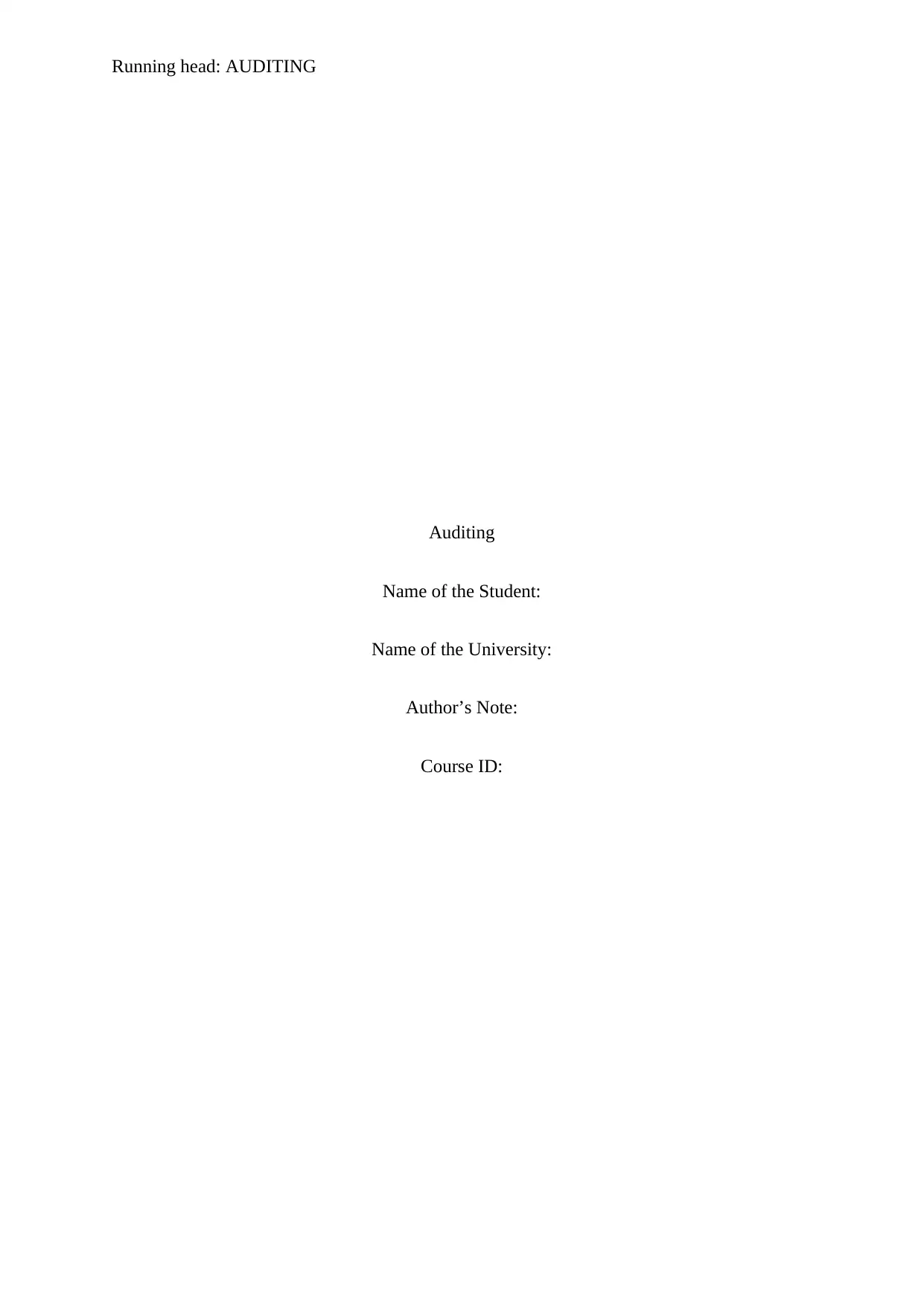
Running head: AUDITING
Auditing
Name of the Student:
Name of the University:
Author’s Note:
Course ID:
Auditing
Name of the Student:
Name of the University:
Author’s Note:
Course ID:
Paraphrase This Document
Need a fresh take? Get an instant paraphrase of this document with our AI Paraphraser
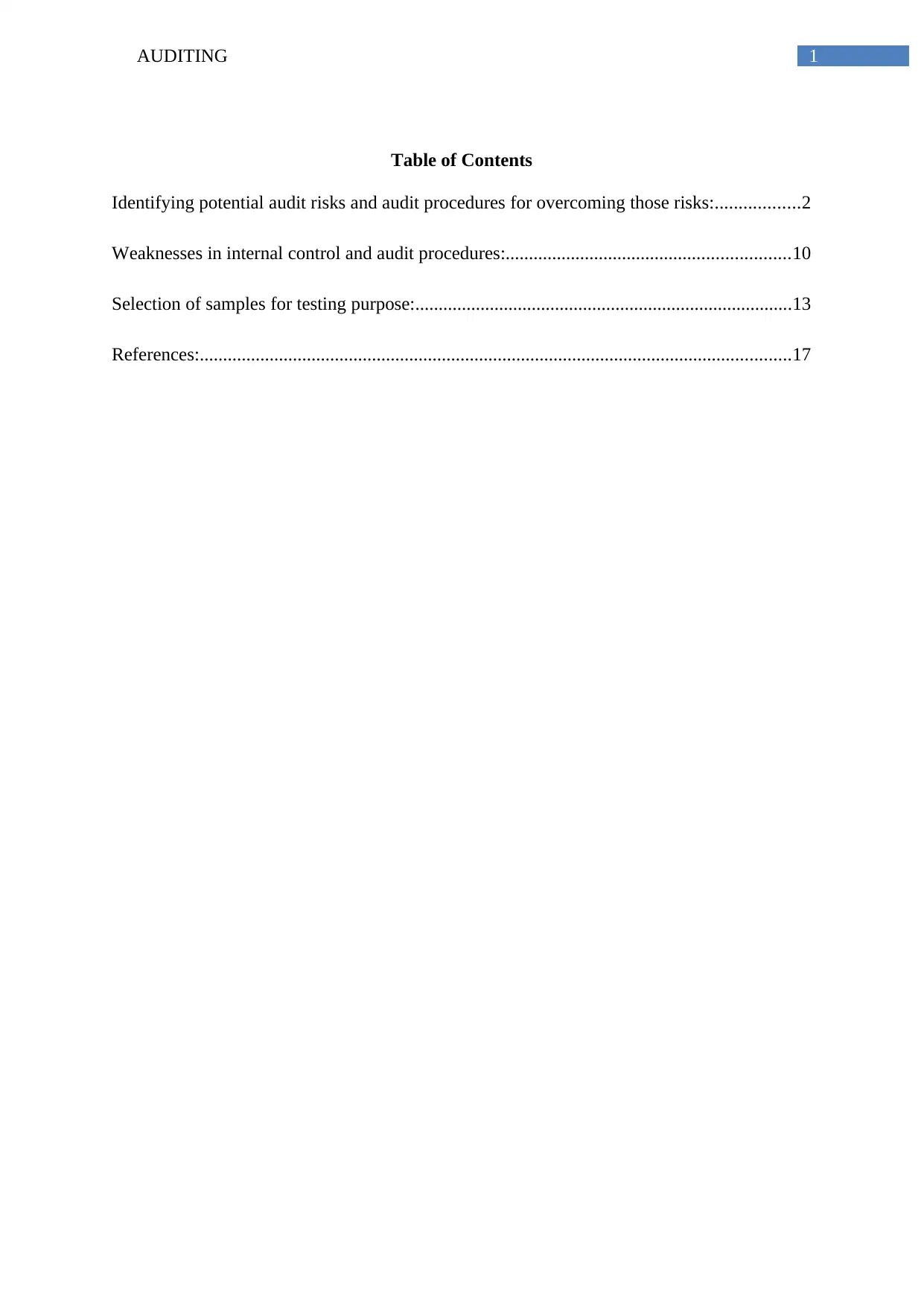
1AUDITING
Table of Contents
Identifying potential audit risks and audit procedures for overcoming those risks:..................2
Weaknesses in internal control and audit procedures:.............................................................10
Selection of samples for testing purpose:.................................................................................13
References:...............................................................................................................................17
Table of Contents
Identifying potential audit risks and audit procedures for overcoming those risks:..................2
Weaknesses in internal control and audit procedures:.............................................................10
Selection of samples for testing purpose:.................................................................................13
References:...............................................................................................................................17
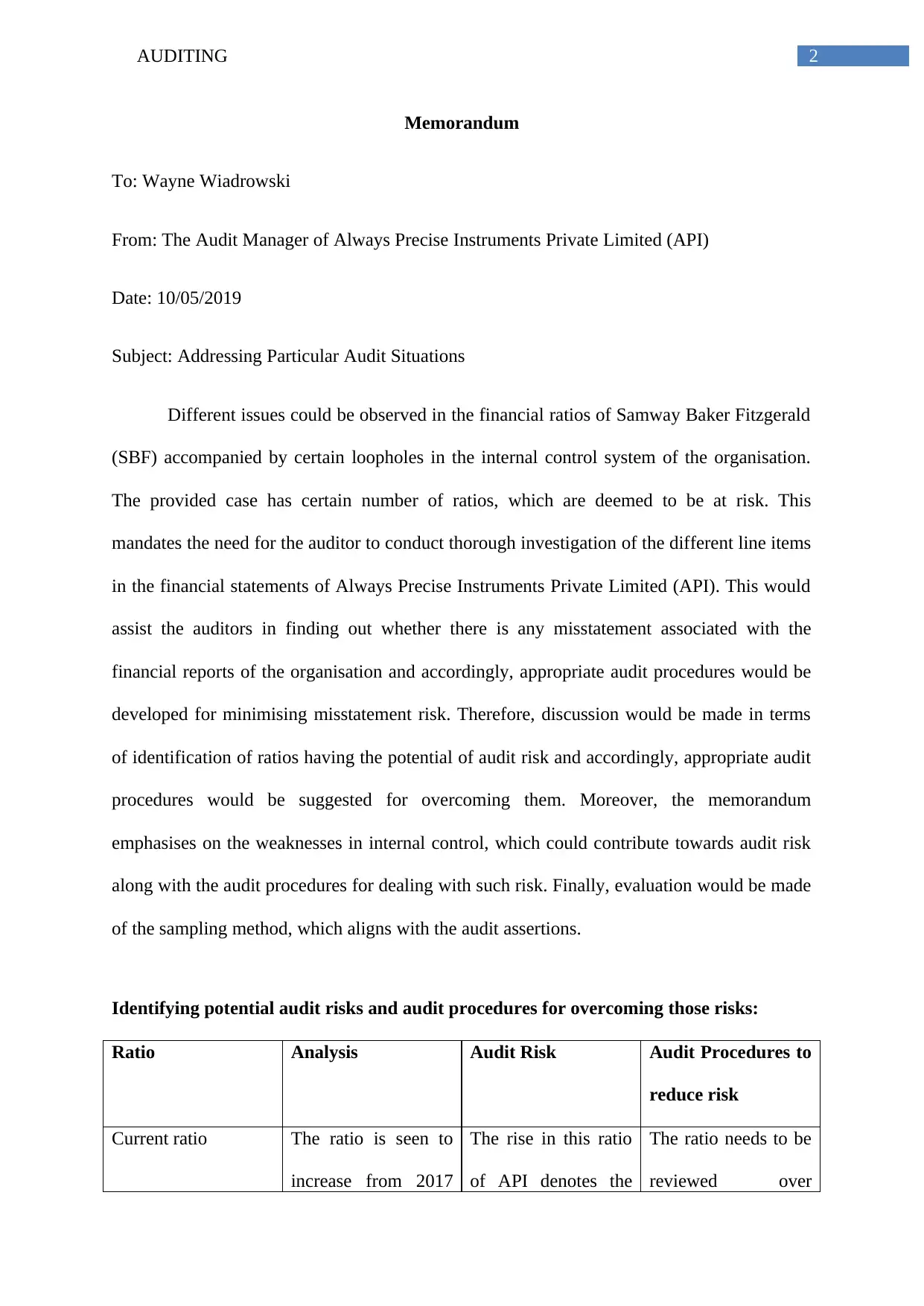
2AUDITING
Memorandum
To: Wayne Wiadrowski
From: The Audit Manager of Always Precise Instruments Private Limited (API)
Date: 10/05/2019
Subject: Addressing Particular Audit Situations
Different issues could be observed in the financial ratios of Samway Baker Fitzgerald
(SBF) accompanied by certain loopholes in the internal control system of the organisation.
The provided case has certain number of ratios, which are deemed to be at risk. This
mandates the need for the auditor to conduct thorough investigation of the different line items
in the financial statements of Always Precise Instruments Private Limited (API). This would
assist the auditors in finding out whether there is any misstatement associated with the
financial reports of the organisation and accordingly, appropriate audit procedures would be
developed for minimising misstatement risk. Therefore, discussion would be made in terms
of identification of ratios having the potential of audit risk and accordingly, appropriate audit
procedures would be suggested for overcoming them. Moreover, the memorandum
emphasises on the weaknesses in internal control, which could contribute towards audit risk
along with the audit procedures for dealing with such risk. Finally, evaluation would be made
of the sampling method, which aligns with the audit assertions.
Identifying potential audit risks and audit procedures for overcoming those risks:
Ratio Analysis Audit Risk Audit Procedures to
reduce risk
Current ratio The ratio is seen to
increase from 2017
The rise in this ratio
of API denotes the
The ratio needs to be
reviewed over
Memorandum
To: Wayne Wiadrowski
From: The Audit Manager of Always Precise Instruments Private Limited (API)
Date: 10/05/2019
Subject: Addressing Particular Audit Situations
Different issues could be observed in the financial ratios of Samway Baker Fitzgerald
(SBF) accompanied by certain loopholes in the internal control system of the organisation.
The provided case has certain number of ratios, which are deemed to be at risk. This
mandates the need for the auditor to conduct thorough investigation of the different line items
in the financial statements of Always Precise Instruments Private Limited (API). This would
assist the auditors in finding out whether there is any misstatement associated with the
financial reports of the organisation and accordingly, appropriate audit procedures would be
developed for minimising misstatement risk. Therefore, discussion would be made in terms
of identification of ratios having the potential of audit risk and accordingly, appropriate audit
procedures would be suggested for overcoming them. Moreover, the memorandum
emphasises on the weaknesses in internal control, which could contribute towards audit risk
along with the audit procedures for dealing with such risk. Finally, evaluation would be made
of the sampling method, which aligns with the audit assertions.
Identifying potential audit risks and audit procedures for overcoming those risks:
Ratio Analysis Audit Risk Audit Procedures to
reduce risk
Current ratio The ratio is seen to
increase from 2017
The rise in this ratio
of API denotes the
The ratio needs to be
reviewed over
⊘ This is a preview!⊘
Do you want full access?
Subscribe today to unlock all pages.

Trusted by 1+ million students worldwide
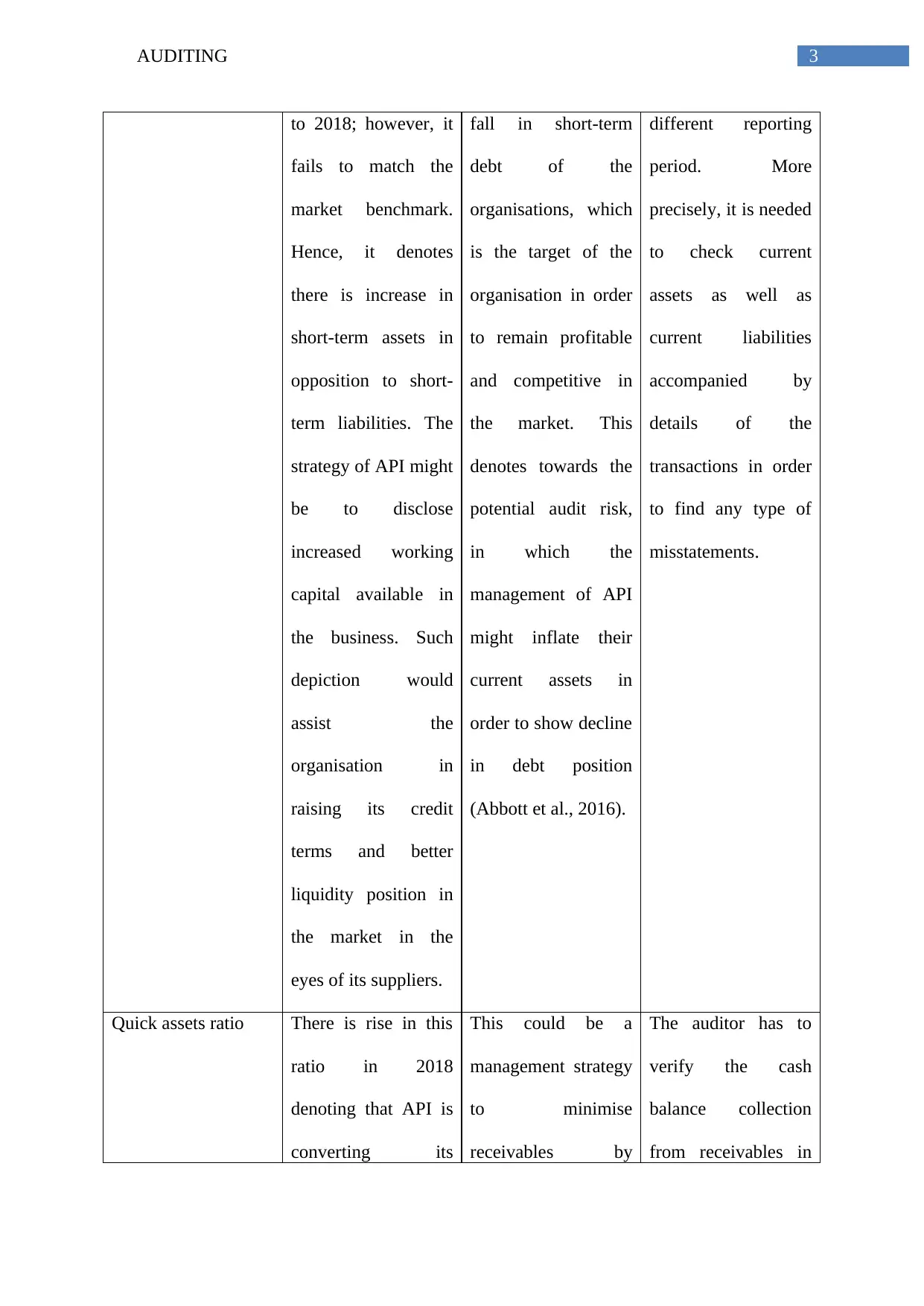
3AUDITING
to 2018; however, it
fails to match the
market benchmark.
Hence, it denotes
there is increase in
short-term assets in
opposition to short-
term liabilities. The
strategy of API might
be to disclose
increased working
capital available in
the business. Such
depiction would
assist the
organisation in
raising its credit
terms and better
liquidity position in
the market in the
eyes of its suppliers.
fall in short-term
debt of the
organisations, which
is the target of the
organisation in order
to remain profitable
and competitive in
the market. This
denotes towards the
potential audit risk,
in which the
management of API
might inflate their
current assets in
order to show decline
in debt position
(Abbott et al., 2016).
different reporting
period. More
precisely, it is needed
to check current
assets as well as
current liabilities
accompanied by
details of the
transactions in order
to find any type of
misstatements.
Quick assets ratio There is rise in this
ratio in 2018
denoting that API is
converting its
This could be a
management strategy
to minimise
receivables by
The auditor has to
verify the cash
balance collection
from receivables in
to 2018; however, it
fails to match the
market benchmark.
Hence, it denotes
there is increase in
short-term assets in
opposition to short-
term liabilities. The
strategy of API might
be to disclose
increased working
capital available in
the business. Such
depiction would
assist the
organisation in
raising its credit
terms and better
liquidity position in
the market in the
eyes of its suppliers.
fall in short-term
debt of the
organisations, which
is the target of the
organisation in order
to remain profitable
and competitive in
the market. This
denotes towards the
potential audit risk,
in which the
management of API
might inflate their
current assets in
order to show decline
in debt position
(Abbott et al., 2016).
different reporting
period. More
precisely, it is needed
to check current
assets as well as
current liabilities
accompanied by
details of the
transactions in order
to find any type of
misstatements.
Quick assets ratio There is rise in this
ratio in 2018
denoting that API is
converting its
This could be a
management strategy
to minimise
receivables by
The auditor has to
verify the cash
balance collection
from receivables in
Paraphrase This Document
Need a fresh take? Get an instant paraphrase of this document with our AI Paraphraser
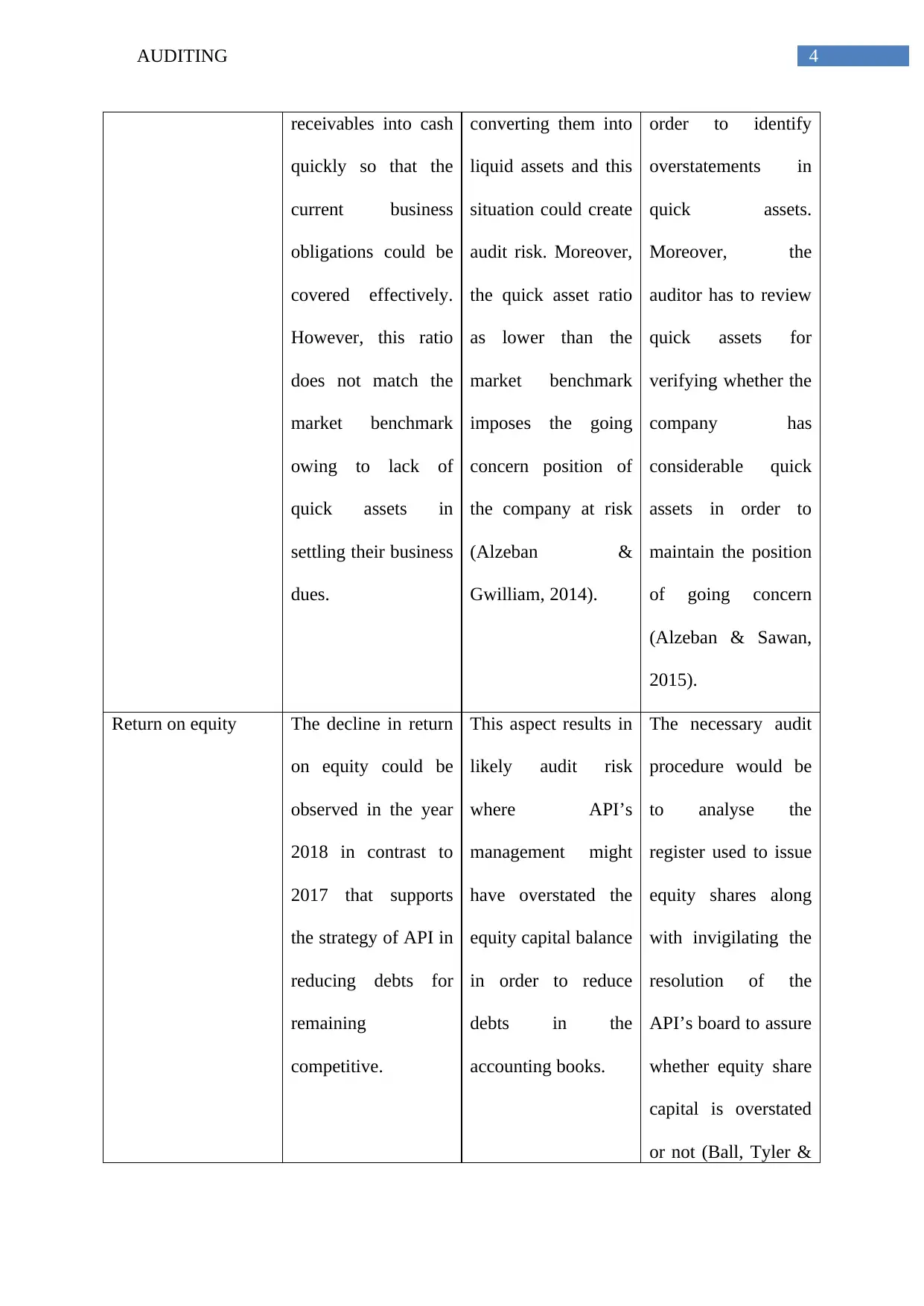
4AUDITING
receivables into cash
quickly so that the
current business
obligations could be
covered effectively.
However, this ratio
does not match the
market benchmark
owing to lack of
quick assets in
settling their business
dues.
converting them into
liquid assets and this
situation could create
audit risk. Moreover,
the quick asset ratio
as lower than the
market benchmark
imposes the going
concern position of
the company at risk
(Alzeban &
Gwilliam, 2014).
order to identify
overstatements in
quick assets.
Moreover, the
auditor has to review
quick assets for
verifying whether the
company has
considerable quick
assets in order to
maintain the position
of going concern
(Alzeban & Sawan,
2015).
Return on equity The decline in return
on equity could be
observed in the year
2018 in contrast to
2017 that supports
the strategy of API in
reducing debts for
remaining
competitive.
This aspect results in
likely audit risk
where API’s
management might
have overstated the
equity capital balance
in order to reduce
debts in the
accounting books.
The necessary audit
procedure would be
to analyse the
register used to issue
equity shares along
with invigilating the
resolution of the
API’s board to assure
whether equity share
capital is overstated
or not (Ball, Tyler &
receivables into cash
quickly so that the
current business
obligations could be
covered effectively.
However, this ratio
does not match the
market benchmark
owing to lack of
quick assets in
settling their business
dues.
converting them into
liquid assets and this
situation could create
audit risk. Moreover,
the quick asset ratio
as lower than the
market benchmark
imposes the going
concern position of
the company at risk
(Alzeban &
Gwilliam, 2014).
order to identify
overstatements in
quick assets.
Moreover, the
auditor has to review
quick assets for
verifying whether the
company has
considerable quick
assets in order to
maintain the position
of going concern
(Alzeban & Sawan,
2015).
Return on equity The decline in return
on equity could be
observed in the year
2018 in contrast to
2017 that supports
the strategy of API in
reducing debts for
remaining
competitive.
This aspect results in
likely audit risk
where API’s
management might
have overstated the
equity capital balance
in order to reduce
debts in the
accounting books.
The necessary audit
procedure would be
to analyse the
register used to issue
equity shares along
with invigilating the
resolution of the
API’s board to assure
whether equity share
capital is overstated
or not (Ball, Tyler &
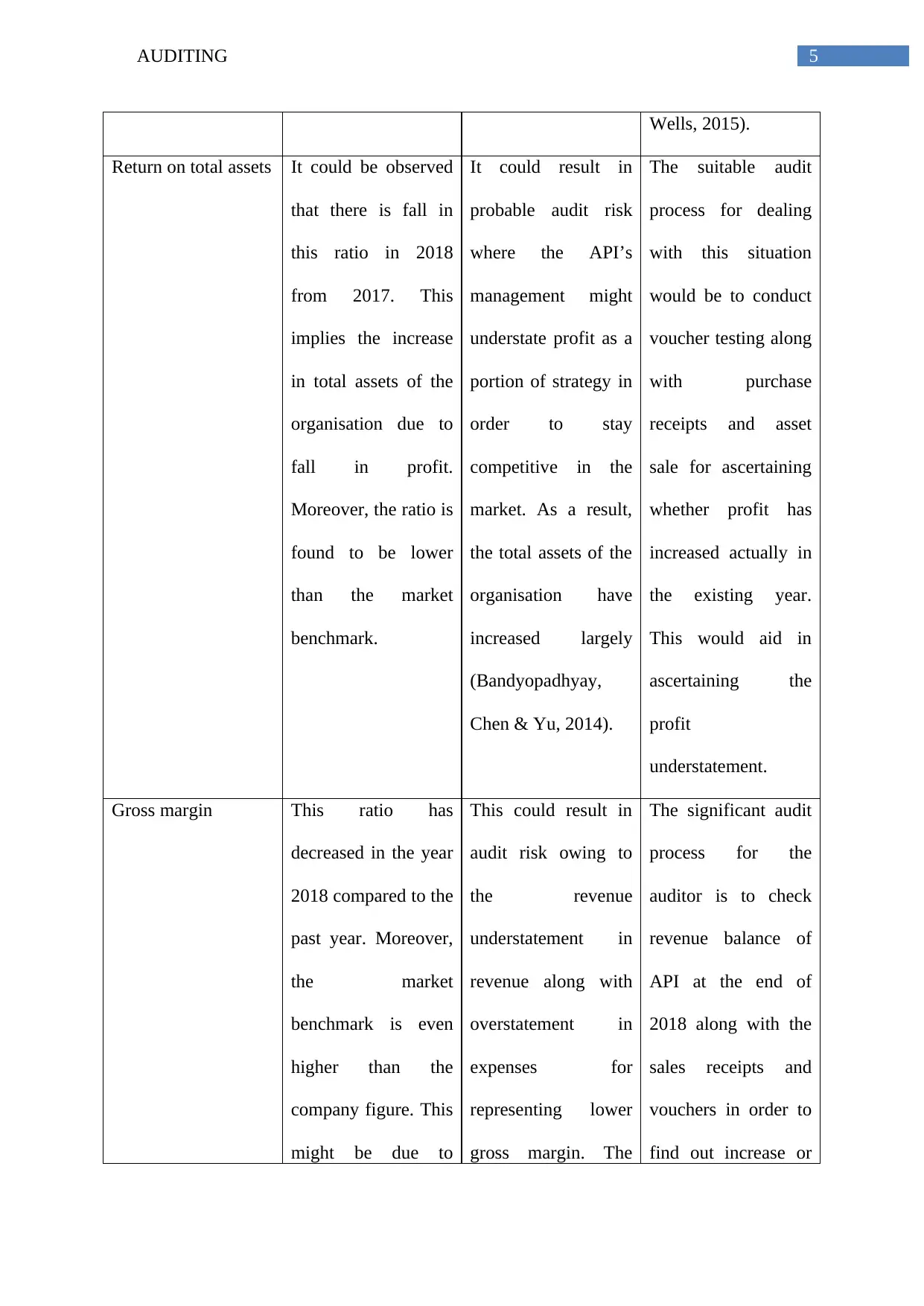
5AUDITING
Wells, 2015).
Return on total assets It could be observed
that there is fall in
this ratio in 2018
from 2017. This
implies the increase
in total assets of the
organisation due to
fall in profit.
Moreover, the ratio is
found to be lower
than the market
benchmark.
It could result in
probable audit risk
where the API’s
management might
understate profit as a
portion of strategy in
order to stay
competitive in the
market. As a result,
the total assets of the
organisation have
increased largely
(Bandyopadhyay,
Chen & Yu, 2014).
The suitable audit
process for dealing
with this situation
would be to conduct
voucher testing along
with purchase
receipts and asset
sale for ascertaining
whether profit has
increased actually in
the existing year.
This would aid in
ascertaining the
profit
understatement.
Gross margin This ratio has
decreased in the year
2018 compared to the
past year. Moreover,
the market
benchmark is even
higher than the
company figure. This
might be due to
This could result in
audit risk owing to
the revenue
understatement in
revenue along with
overstatement in
expenses for
representing lower
gross margin. The
The significant audit
process for the
auditor is to check
revenue balance of
API at the end of
2018 along with the
sales receipts and
vouchers in order to
find out increase or
Wells, 2015).
Return on total assets It could be observed
that there is fall in
this ratio in 2018
from 2017. This
implies the increase
in total assets of the
organisation due to
fall in profit.
Moreover, the ratio is
found to be lower
than the market
benchmark.
It could result in
probable audit risk
where the API’s
management might
understate profit as a
portion of strategy in
order to stay
competitive in the
market. As a result,
the total assets of the
organisation have
increased largely
(Bandyopadhyay,
Chen & Yu, 2014).
The suitable audit
process for dealing
with this situation
would be to conduct
voucher testing along
with purchase
receipts and asset
sale for ascertaining
whether profit has
increased actually in
the existing year.
This would aid in
ascertaining the
profit
understatement.
Gross margin This ratio has
decreased in the year
2018 compared to the
past year. Moreover,
the market
benchmark is even
higher than the
company figure. This
might be due to
This could result in
audit risk owing to
the revenue
understatement in
revenue along with
overstatement in
expenses for
representing lower
gross margin. The
The significant audit
process for the
auditor is to check
revenue balance of
API at the end of
2018 along with the
sales receipts and
vouchers in order to
find out increase or
⊘ This is a preview!⊘
Do you want full access?
Subscribe today to unlock all pages.

Trusted by 1+ million students worldwide
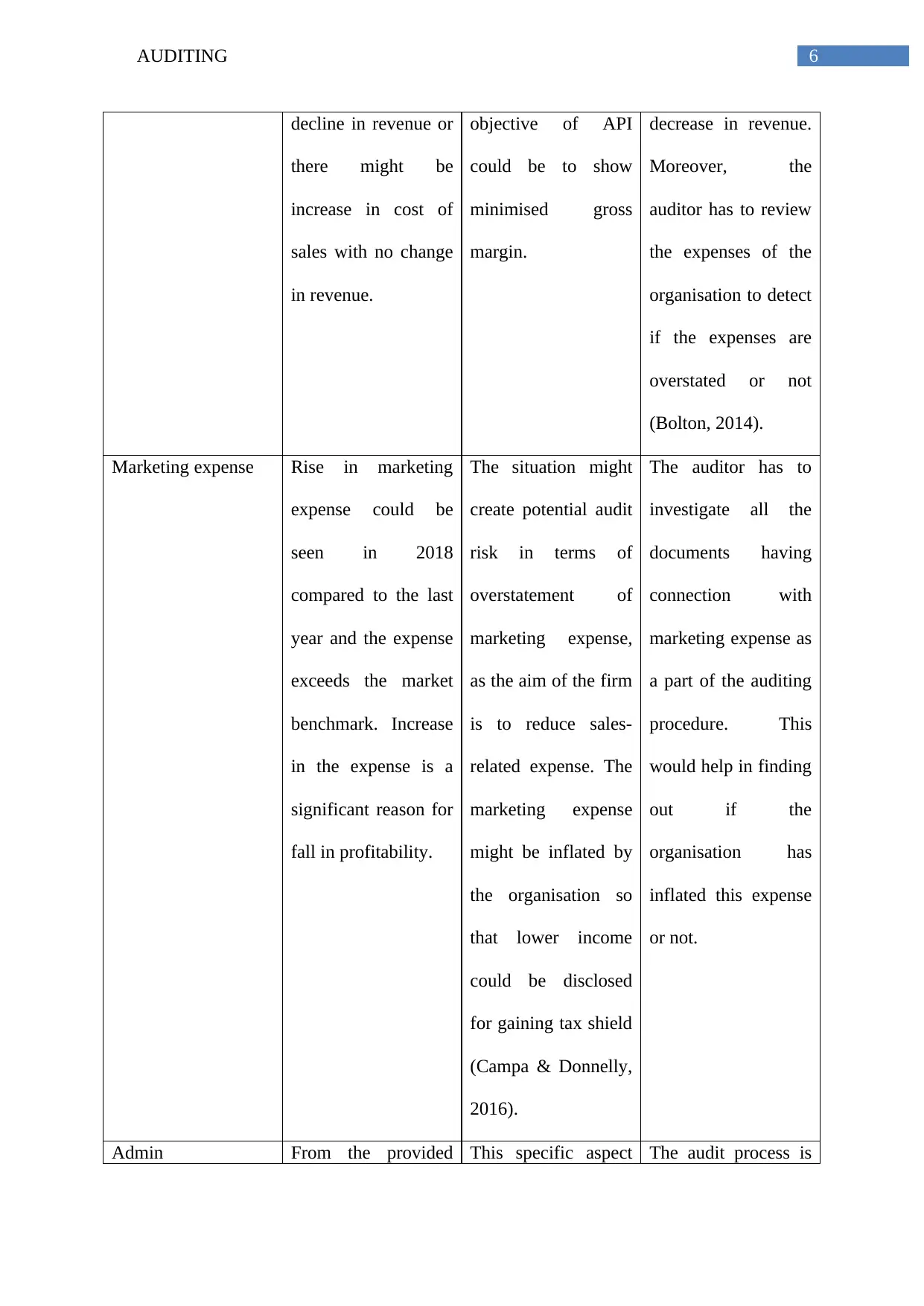
6AUDITING
decline in revenue or
there might be
increase in cost of
sales with no change
in revenue.
objective of API
could be to show
minimised gross
margin.
decrease in revenue.
Moreover, the
auditor has to review
the expenses of the
organisation to detect
if the expenses are
overstated or not
(Bolton, 2014).
Marketing expense Rise in marketing
expense could be
seen in 2018
compared to the last
year and the expense
exceeds the market
benchmark. Increase
in the expense is a
significant reason for
fall in profitability.
The situation might
create potential audit
risk in terms of
overstatement of
marketing expense,
as the aim of the firm
is to reduce sales-
related expense. The
marketing expense
might be inflated by
the organisation so
that lower income
could be disclosed
for gaining tax shield
(Campa & Donnelly,
2016).
The auditor has to
investigate all the
documents having
connection with
marketing expense as
a part of the auditing
procedure. This
would help in finding
out if the
organisation has
inflated this expense
or not.
Admin From the provided This specific aspect The audit process is
decline in revenue or
there might be
increase in cost of
sales with no change
in revenue.
objective of API
could be to show
minimised gross
margin.
decrease in revenue.
Moreover, the
auditor has to review
the expenses of the
organisation to detect
if the expenses are
overstated or not
(Bolton, 2014).
Marketing expense Rise in marketing
expense could be
seen in 2018
compared to the last
year and the expense
exceeds the market
benchmark. Increase
in the expense is a
significant reason for
fall in profitability.
The situation might
create potential audit
risk in terms of
overstatement of
marketing expense,
as the aim of the firm
is to reduce sales-
related expense. The
marketing expense
might be inflated by
the organisation so
that lower income
could be disclosed
for gaining tax shield
(Campa & Donnelly,
2016).
The auditor has to
investigate all the
documents having
connection with
marketing expense as
a part of the auditing
procedure. This
would help in finding
out if the
organisation has
inflated this expense
or not.
Admin From the provided This specific aspect The audit process is
Paraphrase This Document
Need a fresh take? Get an instant paraphrase of this document with our AI Paraphraser
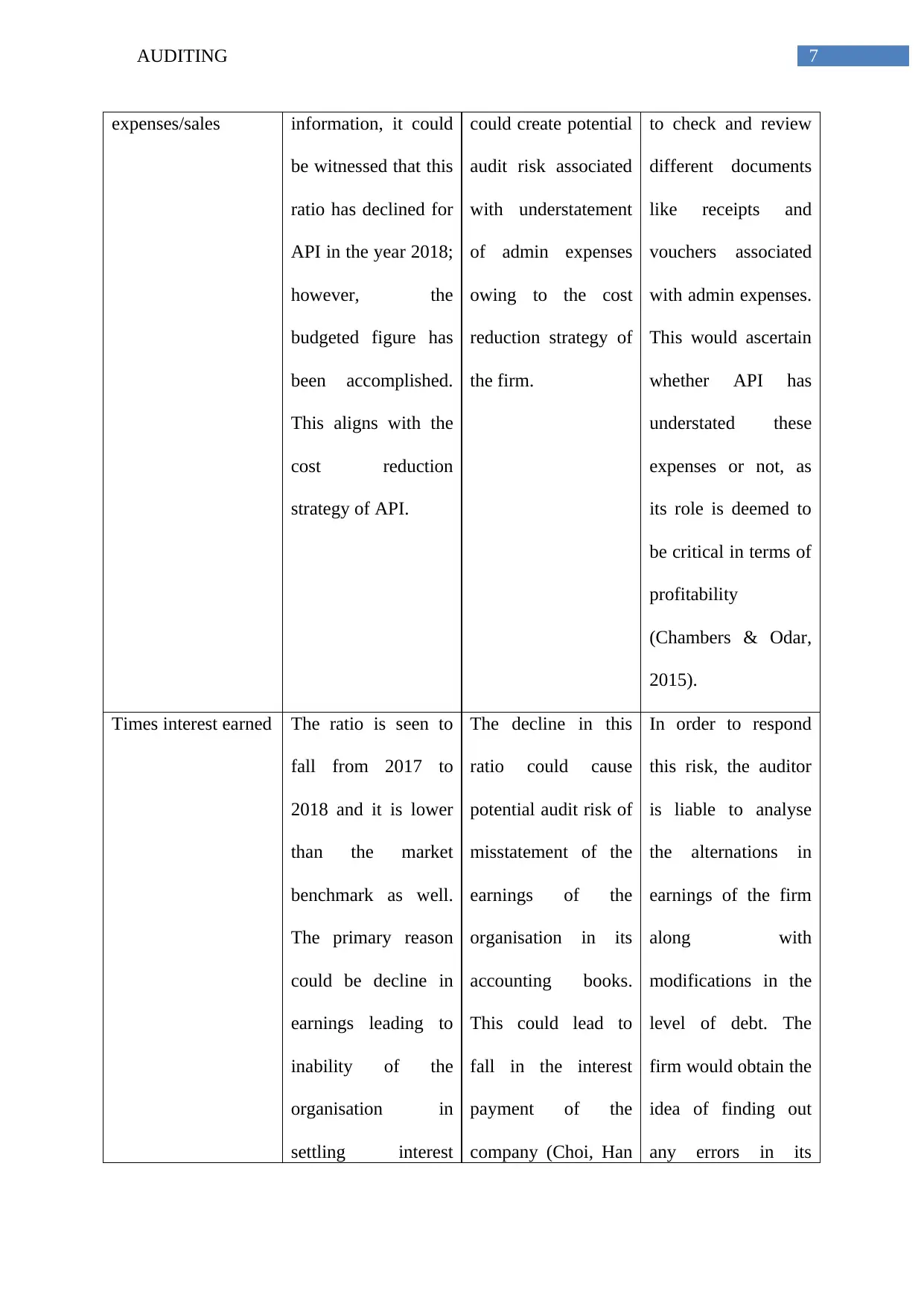
7AUDITING
expenses/sales information, it could
be witnessed that this
ratio has declined for
API in the year 2018;
however, the
budgeted figure has
been accomplished.
This aligns with the
cost reduction
strategy of API.
could create potential
audit risk associated
with understatement
of admin expenses
owing to the cost
reduction strategy of
the firm.
to check and review
different documents
like receipts and
vouchers associated
with admin expenses.
This would ascertain
whether API has
understated these
expenses or not, as
its role is deemed to
be critical in terms of
profitability
(Chambers & Odar,
2015).
Times interest earned The ratio is seen to
fall from 2017 to
2018 and it is lower
than the market
benchmark as well.
The primary reason
could be decline in
earnings leading to
inability of the
organisation in
settling interest
The decline in this
ratio could cause
potential audit risk of
misstatement of the
earnings of the
organisation in its
accounting books.
This could lead to
fall in the interest
payment of the
company (Choi, Han
In order to respond
this risk, the auditor
is liable to analyse
the alternations in
earnings of the firm
along with
modifications in the
level of debt. The
firm would obtain the
idea of finding out
any errors in its
expenses/sales information, it could
be witnessed that this
ratio has declined for
API in the year 2018;
however, the
budgeted figure has
been accomplished.
This aligns with the
cost reduction
strategy of API.
could create potential
audit risk associated
with understatement
of admin expenses
owing to the cost
reduction strategy of
the firm.
to check and review
different documents
like receipts and
vouchers associated
with admin expenses.
This would ascertain
whether API has
understated these
expenses or not, as
its role is deemed to
be critical in terms of
profitability
(Chambers & Odar,
2015).
Times interest earned The ratio is seen to
fall from 2017 to
2018 and it is lower
than the market
benchmark as well.
The primary reason
could be decline in
earnings leading to
inability of the
organisation in
settling interest
The decline in this
ratio could cause
potential audit risk of
misstatement of the
earnings of the
organisation in its
accounting books.
This could lead to
fall in the interest
payment of the
company (Choi, Han
In order to respond
this risk, the auditor
is liable to analyse
the alternations in
earnings of the firm
along with
modifications in the
level of debt. The
firm would obtain the
idea of finding out
any errors in its
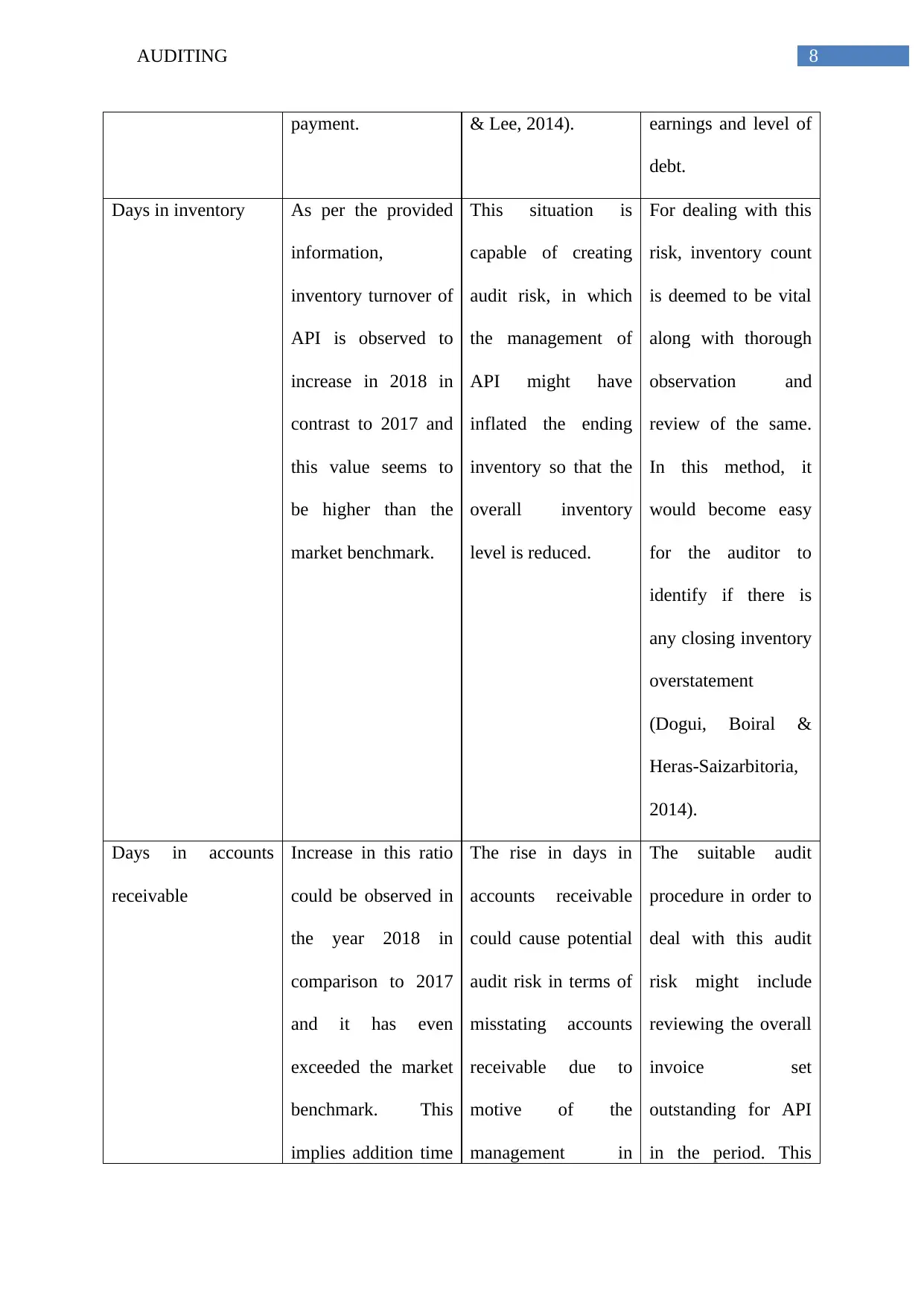
8AUDITING
payment. & Lee, 2014). earnings and level of
debt.
Days in inventory As per the provided
information,
inventory turnover of
API is observed to
increase in 2018 in
contrast to 2017 and
this value seems to
be higher than the
market benchmark.
This situation is
capable of creating
audit risk, in which
the management of
API might have
inflated the ending
inventory so that the
overall inventory
level is reduced.
For dealing with this
risk, inventory count
is deemed to be vital
along with thorough
observation and
review of the same.
In this method, it
would become easy
for the auditor to
identify if there is
any closing inventory
overstatement
(Dogui, Boiral &
Heras‐Saizarbitoria,
2014).
Days in accounts
receivable
Increase in this ratio
could be observed in
the year 2018 in
comparison to 2017
and it has even
exceeded the market
benchmark. This
implies addition time
The rise in days in
accounts receivable
could cause potential
audit risk in terms of
misstating accounts
receivable due to
motive of the
management in
The suitable audit
procedure in order to
deal with this audit
risk might include
reviewing the overall
invoice set
outstanding for API
in the period. This
payment. & Lee, 2014). earnings and level of
debt.
Days in inventory As per the provided
information,
inventory turnover of
API is observed to
increase in 2018 in
contrast to 2017 and
this value seems to
be higher than the
market benchmark.
This situation is
capable of creating
audit risk, in which
the management of
API might have
inflated the ending
inventory so that the
overall inventory
level is reduced.
For dealing with this
risk, inventory count
is deemed to be vital
along with thorough
observation and
review of the same.
In this method, it
would become easy
for the auditor to
identify if there is
any closing inventory
overstatement
(Dogui, Boiral &
Heras‐Saizarbitoria,
2014).
Days in accounts
receivable
Increase in this ratio
could be observed in
the year 2018 in
comparison to 2017
and it has even
exceeded the market
benchmark. This
implies addition time
The rise in days in
accounts receivable
could cause potential
audit risk in terms of
misstating accounts
receivable due to
motive of the
management in
The suitable audit
procedure in order to
deal with this audit
risk might include
reviewing the overall
invoice set
outstanding for API
in the period. This
⊘ This is a preview!⊘
Do you want full access?
Subscribe today to unlock all pages.

Trusted by 1+ million students worldwide
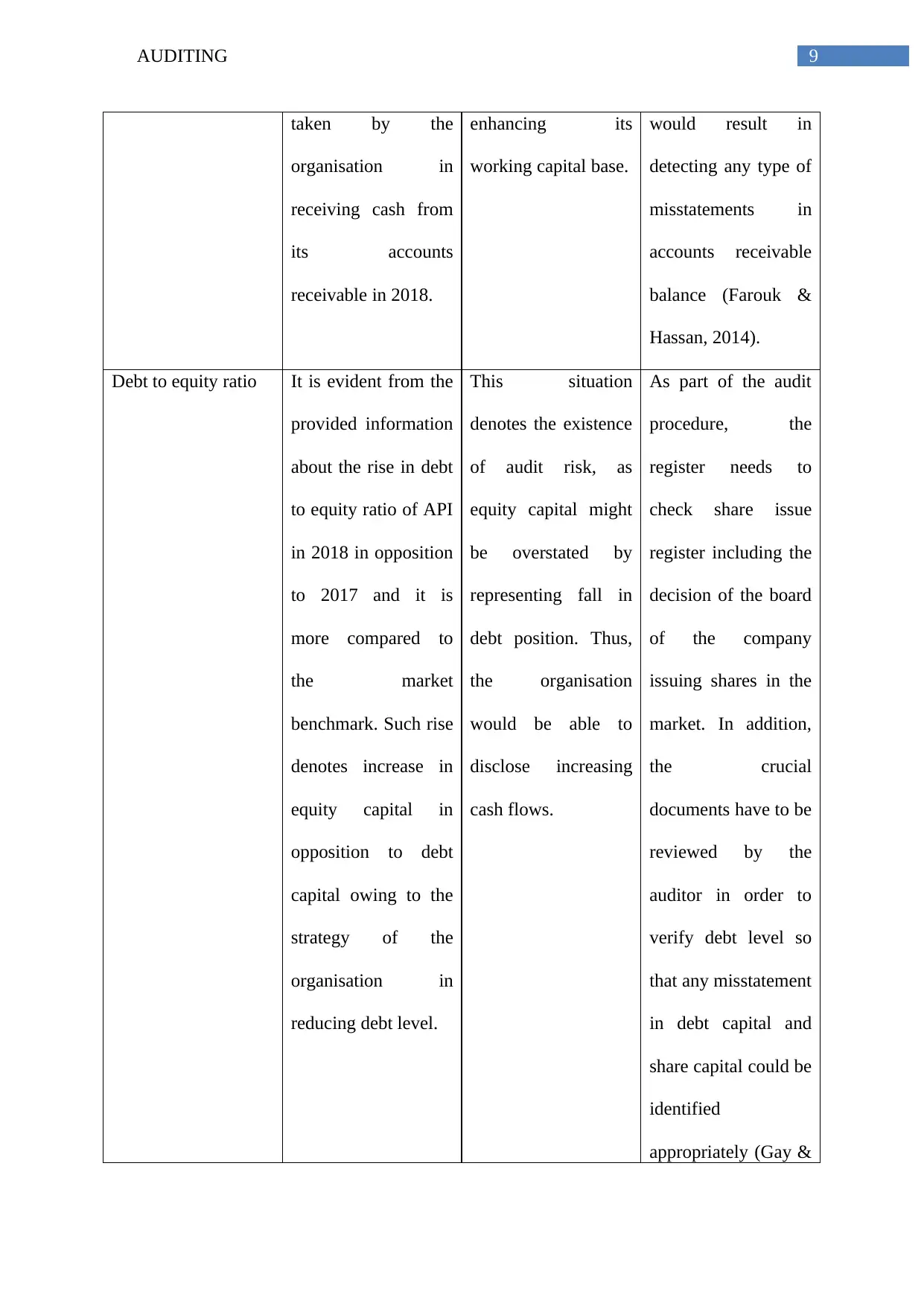
9AUDITING
taken by the
organisation in
receiving cash from
its accounts
receivable in 2018.
enhancing its
working capital base.
would result in
detecting any type of
misstatements in
accounts receivable
balance (Farouk &
Hassan, 2014).
Debt to equity ratio It is evident from the
provided information
about the rise in debt
to equity ratio of API
in 2018 in opposition
to 2017 and it is
more compared to
the market
benchmark. Such rise
denotes increase in
equity capital in
opposition to debt
capital owing to the
strategy of the
organisation in
reducing debt level.
This situation
denotes the existence
of audit risk, as
equity capital might
be overstated by
representing fall in
debt position. Thus,
the organisation
would be able to
disclose increasing
cash flows.
As part of the audit
procedure, the
register needs to
check share issue
register including the
decision of the board
of the company
issuing shares in the
market. In addition,
the crucial
documents have to be
reviewed by the
auditor in order to
verify debt level so
that any misstatement
in debt capital and
share capital could be
identified
appropriately (Gay &
taken by the
organisation in
receiving cash from
its accounts
receivable in 2018.
enhancing its
working capital base.
would result in
detecting any type of
misstatements in
accounts receivable
balance (Farouk &
Hassan, 2014).
Debt to equity ratio It is evident from the
provided information
about the rise in debt
to equity ratio of API
in 2018 in opposition
to 2017 and it is
more compared to
the market
benchmark. Such rise
denotes increase in
equity capital in
opposition to debt
capital owing to the
strategy of the
organisation in
reducing debt level.
This situation
denotes the existence
of audit risk, as
equity capital might
be overstated by
representing fall in
debt position. Thus,
the organisation
would be able to
disclose increasing
cash flows.
As part of the audit
procedure, the
register needs to
check share issue
register including the
decision of the board
of the company
issuing shares in the
market. In addition,
the crucial
documents have to be
reviewed by the
auditor in order to
verify debt level so
that any misstatement
in debt capital and
share capital could be
identified
appropriately (Gay &
Paraphrase This Document
Need a fresh take? Get an instant paraphrase of this document with our AI Paraphraser
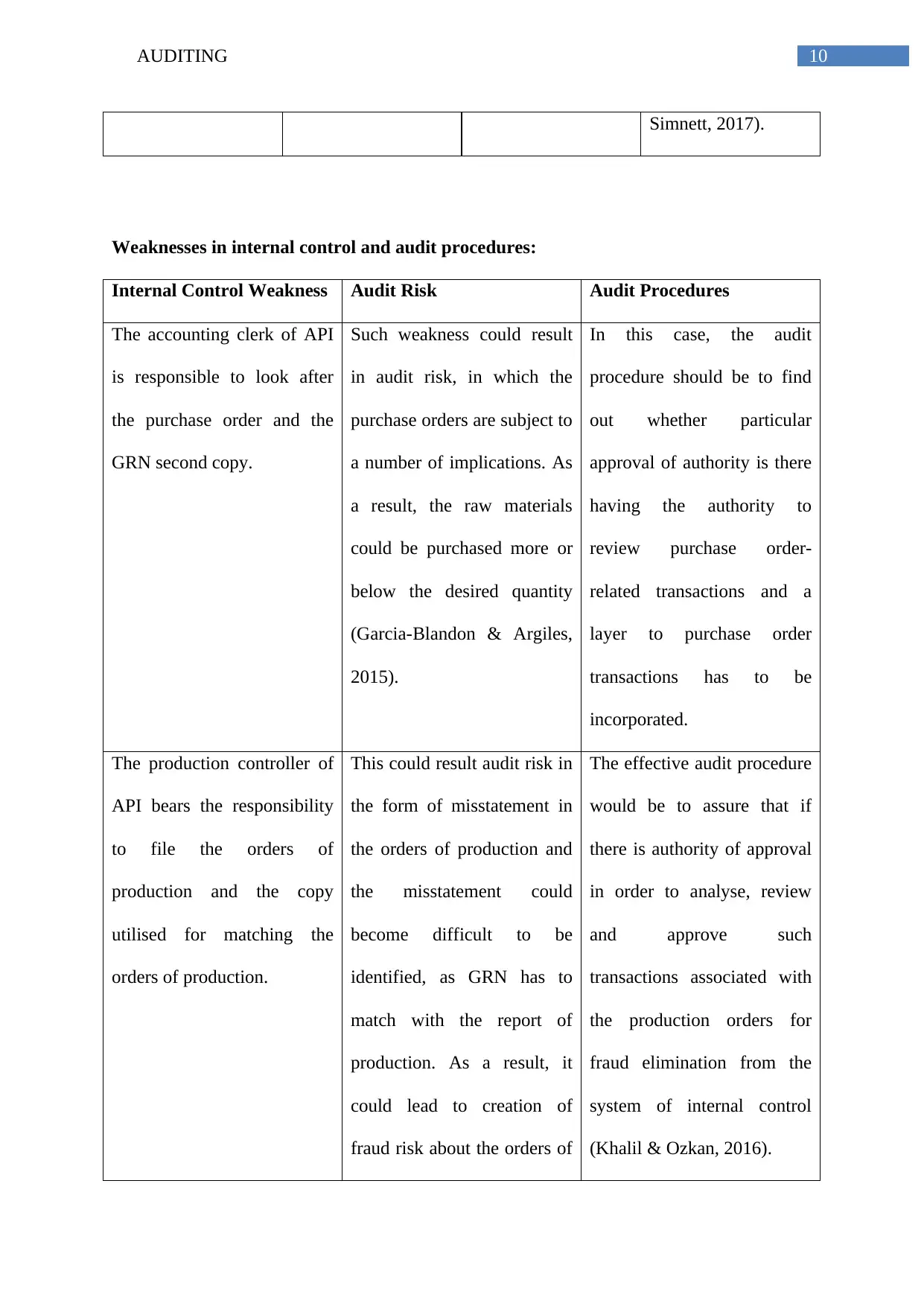
10AUDITING
Simnett, 2017).
Weaknesses in internal control and audit procedures:
Internal Control Weakness Audit Risk Audit Procedures
The accounting clerk of API
is responsible to look after
the purchase order and the
GRN second copy.
Such weakness could result
in audit risk, in which the
purchase orders are subject to
a number of implications. As
a result, the raw materials
could be purchased more or
below the desired quantity
(Garcia-Blandon & Argiles,
2015).
In this case, the audit
procedure should be to find
out whether particular
approval of authority is there
having the authority to
review purchase order-
related transactions and a
layer to purchase order
transactions has to be
incorporated.
The production controller of
API bears the responsibility
to file the orders of
production and the copy
utilised for matching the
orders of production.
This could result audit risk in
the form of misstatement in
the orders of production and
the misstatement could
become difficult to be
identified, as GRN has to
match with the report of
production. As a result, it
could lead to creation of
fraud risk about the orders of
The effective audit procedure
would be to assure that if
there is authority of approval
in order to analyse, review
and approve such
transactions associated with
the production orders for
fraud elimination from the
system of internal control
(Khalil & Ozkan, 2016).
Simnett, 2017).
Weaknesses in internal control and audit procedures:
Internal Control Weakness Audit Risk Audit Procedures
The accounting clerk of API
is responsible to look after
the purchase order and the
GRN second copy.
Such weakness could result
in audit risk, in which the
purchase orders are subject to
a number of implications. As
a result, the raw materials
could be purchased more or
below the desired quantity
(Garcia-Blandon & Argiles,
2015).
In this case, the audit
procedure should be to find
out whether particular
approval of authority is there
having the authority to
review purchase order-
related transactions and a
layer to purchase order
transactions has to be
incorporated.
The production controller of
API bears the responsibility
to file the orders of
production and the copy
utilised for matching the
orders of production.
This could result audit risk in
the form of misstatement in
the orders of production and
the misstatement could
become difficult to be
identified, as GRN has to
match with the report of
production. As a result, it
could lead to creation of
fraud risk about the orders of
The effective audit procedure
would be to assure that if
there is authority of approval
in order to analyse, review
and approve such
transactions associated with
the production orders for
fraud elimination from the
system of internal control
(Khalil & Ozkan, 2016).
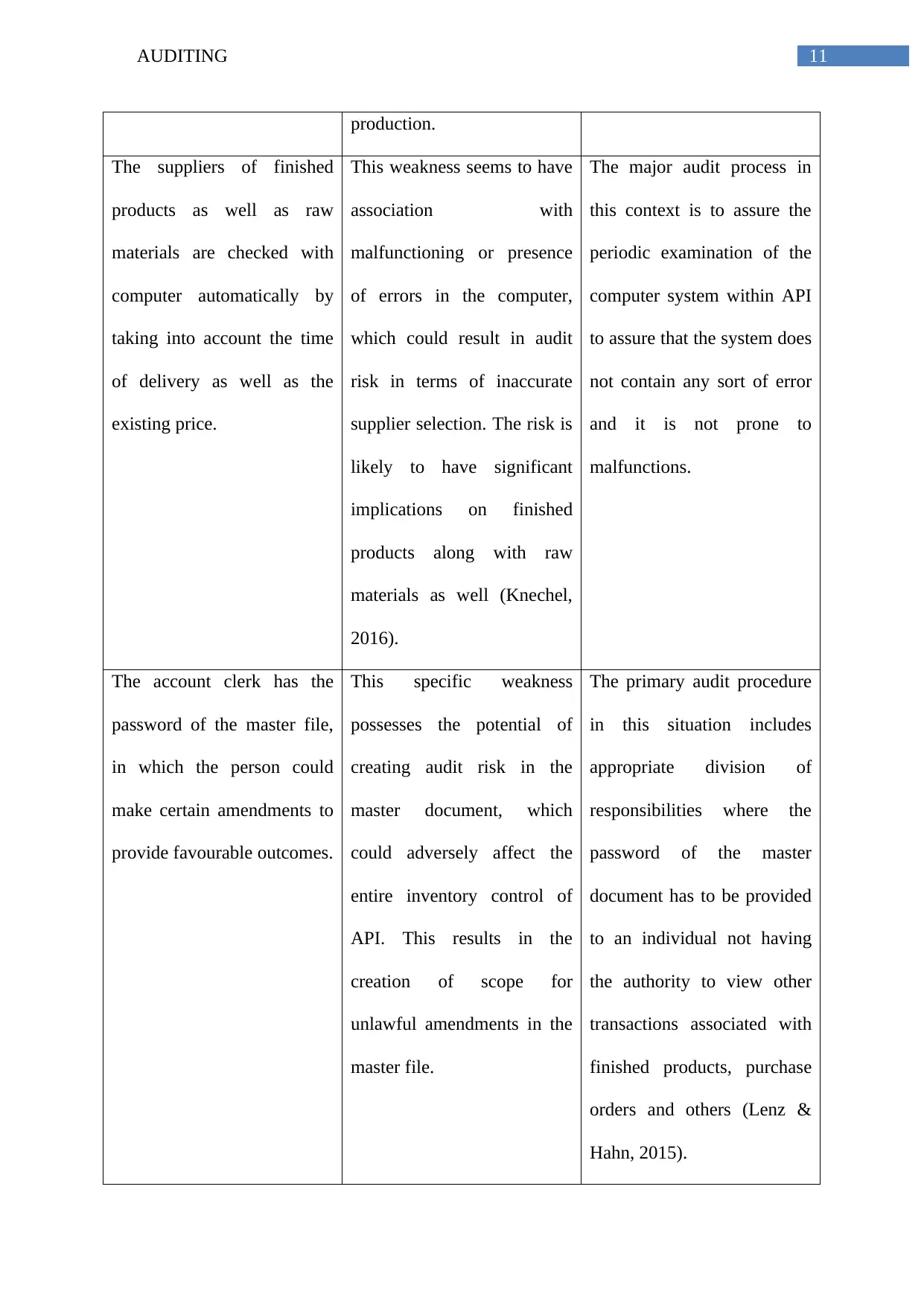
11AUDITING
production.
The suppliers of finished
products as well as raw
materials are checked with
computer automatically by
taking into account the time
of delivery as well as the
existing price.
This weakness seems to have
association with
malfunctioning or presence
of errors in the computer,
which could result in audit
risk in terms of inaccurate
supplier selection. The risk is
likely to have significant
implications on finished
products along with raw
materials as well (Knechel,
2016).
The major audit process in
this context is to assure the
periodic examination of the
computer system within API
to assure that the system does
not contain any sort of error
and it is not prone to
malfunctions.
The account clerk has the
password of the master file,
in which the person could
make certain amendments to
provide favourable outcomes.
This specific weakness
possesses the potential of
creating audit risk in the
master document, which
could adversely affect the
entire inventory control of
API. This results in the
creation of scope for
unlawful amendments in the
master file.
The primary audit procedure
in this situation includes
appropriate division of
responsibilities where the
password of the master
document has to be provided
to an individual not having
the authority to view other
transactions associated with
finished products, purchase
orders and others (Lenz &
Hahn, 2015).
production.
The suppliers of finished
products as well as raw
materials are checked with
computer automatically by
taking into account the time
of delivery as well as the
existing price.
This weakness seems to have
association with
malfunctioning or presence
of errors in the computer,
which could result in audit
risk in terms of inaccurate
supplier selection. The risk is
likely to have significant
implications on finished
products along with raw
materials as well (Knechel,
2016).
The major audit process in
this context is to assure the
periodic examination of the
computer system within API
to assure that the system does
not contain any sort of error
and it is not prone to
malfunctions.
The account clerk has the
password of the master file,
in which the person could
make certain amendments to
provide favourable outcomes.
This specific weakness
possesses the potential of
creating audit risk in the
master document, which
could adversely affect the
entire inventory control of
API. This results in the
creation of scope for
unlawful amendments in the
master file.
The primary audit procedure
in this situation includes
appropriate division of
responsibilities where the
password of the master
document has to be provided
to an individual not having
the authority to view other
transactions associated with
finished products, purchase
orders and others (Lenz &
Hahn, 2015).
⊘ This is a preview!⊘
Do you want full access?
Subscribe today to unlock all pages.

Trusted by 1+ million students worldwide
1 out of 20
Related Documents
Your All-in-One AI-Powered Toolkit for Academic Success.
+13062052269
info@desklib.com
Available 24*7 on WhatsApp / Email
![[object Object]](/_next/static/media/star-bottom.7253800d.svg)
Unlock your academic potential
Copyright © 2020–2025 A2Z Services. All Rights Reserved. Developed and managed by ZUCOL.





